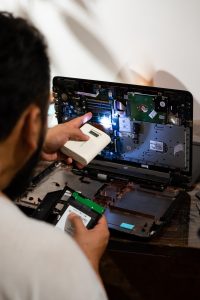The Internet of Things (IoT) is transforming businesses across every industry by interconnecting people, processes, data, and physical objects in an unprecedented way. As more smart, connected devices enter our workplaces and daily lives, IoT presents boundless opportunities for organizations to optimize operations, create new products and revenue streams, and deliver intelligent customer experiences.
However, successfully leveraging IoT also surfaces critical challenges around security, data privacy, and system interoperability that must be carefully navigated. In this post, we’ll explore the evolving role of IoT in the business world and provide insights into harnessing its full potential while mitigating the risks.
The Explosion of IoT Adoption
First, let’s examine the rapid proliferation of IoT and its key drivers. There are over 10 billion IoT devices deployed worldwide currently, a number projected to more than double by 2025. Global IoT spending is estimated to surpass $1 trillion this year.
Key factors accelerating adoption include:
– Expanding ecosystem – More affordable, scalable IoT platforms, sensors, and infrastructure expand capabilities and lower barriers to entry.
– ROI – Companies see material cost savings, productivity gains, and revenue growth providing concrete returns on investment.
– Data insights – IoT generates real-time data and analytics to inform smarter business decisions.
– Remote capabilities – IoT allows managing distributed assets, inventory, and locations more efficiently.
– Emerging technologies – 5G, edge computing, and AI unlock more sophisticated IoT tools and applications.
As IoT ecosystems and use cases mature, we’ll see businesses integrate connected technologies throughout their operations and products.
IoT Use Cases Driving Business Value
How exactly is IoT creating value across industries? Here are some of the most impactful applications:
– Smart factories – IoT optimizes manufacturing via predictive maintenance on equipment, asset tracking, autonomous robots, and logistics monitoring.
– Inventory and warehouse management – Smart shelves track inventory levels; IoT sensors monitor storage conditions like temperature.
– Fleet management – IoT devices in company vehicles improve routing, fuel efficiency, maintenance, and driver safety.
– Smart offices – Automated HVAC, lighting, and other building controls activated by occupancy sensors reduce energy usage.
– Remote asset monitoring – Utilities, telecoms, and energy firms remotely track infrastructure and equipment telemetry via IoT.
– Smart, connected products – IoT allows companies across industries to launch sensor-equipped products with usage analytics, maintenance alerts, and intelligent features.
– Enhanced customer service – Using IoT location beacons and motion sensors, retailers can offer personalized promotions and services.
These applications drive tangible benefits from optimized operations to new revenue streams to improved customer experiences. According to Microsoft, organizations gain an average 30% increase in profitability by digitally transforming with IoT.
IoT Implementation Challenges
However, for IT and OT (operational technology) teams, effectively deploying and managing IoT brings imposing challenges:
Data Security & Privacy
IoT devices and their data flows are prime targets for cyberattacks like DDoS, ransomware, spoofing, and espionage. Rigorous controls are required to safeguard networks, identify vulnerabilities, and block intrusions. Also, IoT data privacy must be ensured or companies risk violations and mistrust.
System Interoperability & Complexity
With disparate IoT vendors, platforms and protocols, getting devices and subsystems to seamlessly integrate can be arduous. Lack of standardization also hinders scalability across sites and geographies. IoT complexity itself strains IT resources.
Connectivity & Bandwidth
IoT depends on consistent, high-bandwidth connectivity between endpoints, networks, clouds, gateways and applications. Limitations or outages disrupt operations and disable remote management capabilities.
Data Management Challenges
The sheer volume and velocity of IoT data can overwhelm storage infrastructure and create bottlenecks. Converting raw data into usable insights is also difficult without analytics skills and tools.
Uncertain ROI
projection also requires factoring in security, maintenance, solution integration, personnel and training costs.
While IoT creates tangible value, it also taxes IT infrastructure, security, and skills. Organizations must address these hurdles to successfully harness its potential.
An Effective IoT Strategy
So how should business and technology leaders strategize? Here are best practices to maximize your IoT return:
– Start small – Run controlled pilots focused on one process or product and validate ROI before scaling.
– Choose connectivity carefully – Audit where wired versus wireless connectivity work best, factoring in bandwidth, security and cost.
– Build with security in mind – Adopt a Secure by Design approach baking in encryption, access controls, and cyber resilience from the start.
– Simplify integration – Select platforms using open, widely adopted protocols for easier connectivity. Also limit the vendors and technologies in your ecosystem.
– Invest in data capabilities – Modernize pipelines, analytics skillsets, and visualization tools to extract actionable IoT insights.
– Partner strategically – Leverage experienced IoT firms to fill skills gaps around deployment, security, integration, and data analytics.
– Plan for scale – Architect IoT infrastructure with redundancy, automated device management, and failover capabilities for growth.
– Start with clear use cases – Ensure IoT projects fulfill concrete business objectives whether improved efficiencies, customer experiences or new offerings.
With an executing balancing strategic expansion and risk mitigation, organizations can harness IoT as a core competitive advantage.
The Future of IoT
IoT will continue proliferating amid edge computing, 5G, AI, digital twin modeling, and other emerging technologies. As devices get smarter and more interconnected, new applications will transform healthcare, manufacturing, retail, transportation, and entertainment. But greater connectivity also demands improved security and more thoughtful data ethics. Companies able to strategically adopt IoT while ensuring privacy and resilience will win in their digital transformation efforts. With sound strategy, IoT unlocks immense opportunities for business innovation and success.




